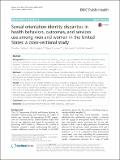| dc.contributor.author | Jackson, Chandra L. | en_US |
| dc.contributor.author | Agénor, Madina | en_US |
| dc.contributor.author | Johnson, Dayna A. | en_US |
| dc.contributor.author | Austin, S. Bryn | en_US |
| dc.contributor.author | Kawachi, Ichiro | en_US |
| dc.date.accessioned | 2016-10-11T20:28:58Z | |
| dc.date.issued | 2016 | en_US |
| dc.identifier.citation | Jackson, Chandra L., Madina Agénor, Dayna A. Johnson, S. Bryn Austin, and Ichiro Kawachi. 2016. “Sexual orientation identity disparities in health behaviors, outcomes, and services use among men and women in the United States: a cross-sectional study.” BMC Public Health 16 (1): 807. doi:10.1186/s12889-016-3467-1. http://dx.doi.org/10.1186/s12889-016-3467-1. | en |
| dc.identifier.issn | 1471-2458 | en |
| dc.identifier.uri | http://nrs.harvard.edu/urn-3:HUL.InstRepos:29002724 | |
| dc.description.abstract | Background: Research shows that sexual minorities (e.g., lesbian, gay, and bisexual individuals) experience higher levels of discrimination, stigma, and stress and are at higher risk of some poor health outcomes and health behaviors compared to their heterosexual counterparts. However, the majority of studies have examined sexual orientation disparities in a narrow range of health outcomes and behaviors using convenience samples comprised of either men or women living in restricted geographic areas. Methods: To investigate the relationship between sexual orientation identity and health among U.S. women and men, we used Poisson regression with robust variance to estimate prevalence ratios for health behaviors, outcomes, and services use comparing sexual minorities to heterosexual individuals using 2013 and 2014 National Health Interview Survey data (N = 69,270). Results: Three percent of the sample identified as sexual minorities. Compared to heterosexual women, lesbian (prevalence ratio (PR) = 1.65 [95 % confidence interval (CI): 1.14, 2.37]) and bisexual (PR = 2.16 [1.46, 3.18]) women were more likely to report heavy drinking. Lesbians had a higher prevalence of obesity (PR = 1.20 [1.02, 1.42]), stroke (PR = 1.96 [1.14, 3.39]), and functional limitation (PR = 1.17 [1.02, 1.34] than heterosexual women. Gay men were more likely to have hypertension (PR = 1.21 [1.03, 1.43]) and heart disease (PR = 1.39 [1.02, 1.88]). Despite no difference in health insurance status, sexual minorities were more likely than heterosexual individuals to delay seeking healthcare because of cost; however, members of this group were also more likely to have received an HIV test and initiated HPV vaccination. Conclusion: Sexual minorities had a higher prevalence of some poor health behaviors and outcomes. | en |
| dc.language.iso | en_US | en |
| dc.publisher | BioMed Central | en |
| dc.relation.isversionof | doi:10.1186/s12889-016-3467-1 | en |
| dc.relation.hasversion | http://www.ncbi.nlm.nih.gov/pmc/articles/PMC4989521/pdf/ | en |
| dash.license | LAA | en_US |
| dc.subject | Sexual orientation | en |
| dc.subject | Health behaviors | en |
| dc.subject | Health outcomes | en |
| dc.subject | United States | en |
| dc.title | Sexual orientation identity disparities in health behaviors, outcomes, and services use among men and women in the United States: a cross-sectional study | en |
| dc.type | Journal Article | en_US |
| dc.description.version | Version of Record | en |
| dc.relation.journal | BMC Public Health | en |
| dash.depositing.author | Agénor, Madina | en_US |
| dc.date.available | 2016-10-11T20:28:58Z | |
| dc.identifier.doi | 10.1186/s12889-016-3467-1 | * |
| dash.contributor.affiliated | Agenor, Madina | |
| dash.contributor.affiliated | Johnson, Dayna | |
| dash.contributor.affiliated | Kawachi, Ichiro | |


